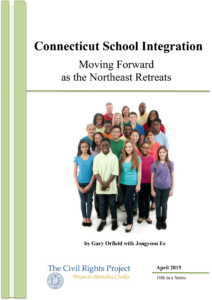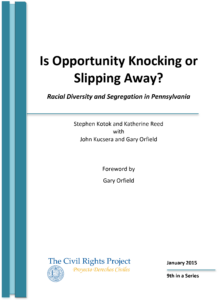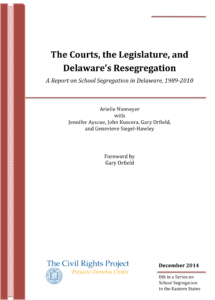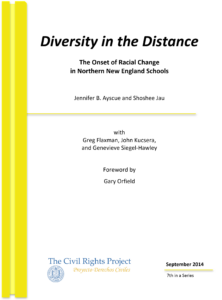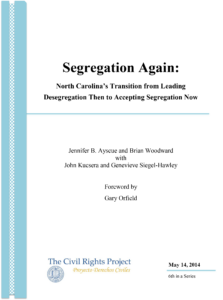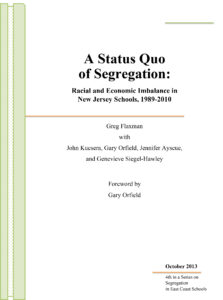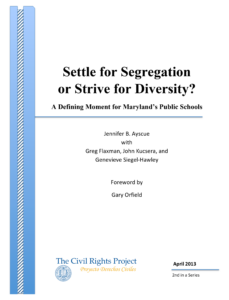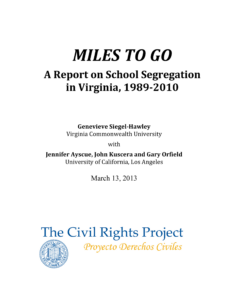Executive Summary
In 1881, a New Jersey statute was enacted that prohibited segregated schooling based on race, one of the very first such laws in the nation. In 1947, New Jersey adopted a state constitutional provision that specifically prohibited segregation in the public schools. It is the only state with such an explicit provision. Connecticut’s state constitution, the next strongest, bars “segregation or discrimination in the exercise or enjoyment of his or her civil or political rights,” but it does not specify the public schools.
In the period from 1944 through 1971, the New Jersey courts, especially after the 1947 constitution dramatically strengthened the judicial branch, rendered a series of decisions that strongly supported desegregation and racial balance in the schools. Indeed, the state’s courts went far beyond the federal courts in establishing doctrine that made racial balance in the schools a high priority and its realization a possibility.
Nonetheless, the reality on the ground has never measured up to the strong legal doctrine, and since 1971 the state courts have been much less bold in their race-related rulings.
Against that legal and historical backdrop, this study explores demographic changes in New Jersey schools from 1989 to 2010, based on federal data from the National Center for Education Statistics. It utilizes measures such as the concentration of students of color and the exposure of a student of one race to students of another to examine the presence of segregation in schools throughout the state.
Major findings presented in the report include:
- The state has witnessed a rise in the proportionate enrollment of Latino and Asian students, with the percentage of these students doubling over the last 20 years from
- 11% to 22% and 4% to 9%, respectively. Meanwhile, enrollment of white and black students relative to total enrollment has decreased, from 66% to 52% and 18% to
16%, respectively. - A majority of students at suburban schools in northern and central New Jersey (North and Central Jersey) and in Southern New Jersey (South Jersey) continue to be white, with 51% in North and Central Jersey and 63% in South Jersey. The majority of students in urban schools in North and Central Jersey are black, as was the case 20 years ago, yet the Latino student population is trending toward a shared majority with black students, having experienced an increase from 26% of enrollment to 42%. Urban schools in South Jersey have become majority Latino, from 29% of enrollment in 1989-1990 to 43% in 2010-2011.
- School enrollment trends in New Jersey over the past two decades indicate increasing racial isolation for Latino students, and reduced isolation for black students on some measures with signs of persistent segregation on others. Current segregation patterns demonstrate that a greater number of schools in New Jersey are now much more concentrated minority schools compared to 20 years ago, with 26% of black students and 13% of Latino students in the state attending apartheid schools (those with 99-100% enrollment of students of color). The proportion of these highly segregated schools in New Jersey increased by two-thirds between 1989 and 2010, from 4.8% to 8%.
- The typical black student and typical Latino student attend schools with a share of low-income students that is more than three times higher than the share of low-income students in the school of a typical white student (nearly three-fifths compared to less than one-fifth). This income disparity signifies the presence of double segregation in the state by race and class. These trends are also present in the North and Central Jersey and South Jersey metropolitan areas, although there is significantly less racial isolation for black students and Latino students in South Jersey than in North Central Jersey.
- There are some signs of progress in terms of having more diverse schools in the state. The proportion of schools considered multiracial, in which the three major racial groups (Asian students, white students, black students, and Latino students) are represented by at least 10% of the student body, increased from 10% to 26% between 1989-1990 and 2010-2011. Students in the state have also become more evenly distributed when comparing the average school’s racial composition to the racial composition of the entire student population, with a 19% decrease in the percentage of the New Jersey student population that would have needed to attend different schools to achieve complete racial balance. While this represents a positive step, racial imbalance in New Jersey remained high in 2010, as the average school was 35% less diverse than the statewide student population.
School segregation in New Jersey today results from residential patterns of urbanization and suburbanization in the state, where minority students largely inhabit urban areas while white students make up the vast majority of suburban students. As New Jersey school district boundaries correspond with their municipalities, distinctly different racial compositions exist for schools in the suburbs versus urban cities. Housing policy that supports integrated communities, both racially and socioeconomically, can ameliorate this underlying cause of school segregation in the state. Other actions that could increase racial balance include regional school district consolidation and additional public school choice options that emphasize desegregation, such as the magnet schools in Montclair, New Jersey.
This report is part of a special series, “School Segregation Trends in the Eastern States.” These studies explore trends in enrollment and school segregation patterns from 1989 to 2010 at the state and regional levels, including various metro areas for each state. The reports also document the history of school desegregation in each state and across its geographic regions, including key desegregation cases and remedies, when applicable.
In compliance with the UC Open Access Policy, this report has been made available on eScholarship:

